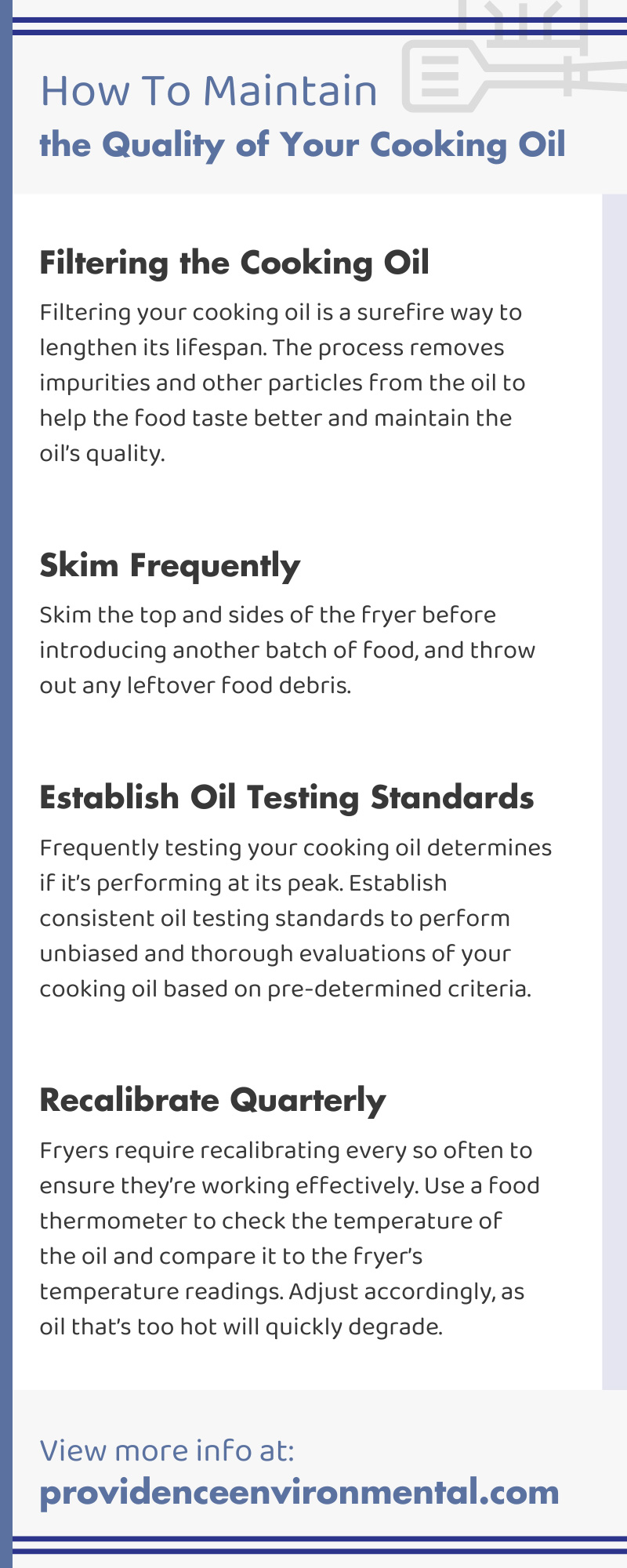Cooking oil is essential for most restaurants and other food service establishments. You can ruin a dish by setting the fryer to the wrong temperature or using low-quality oil.
With rising oil costs, it’s important to learn how to maintain the quality of your cooking oil, to ensure you’re getting the most out of it. You’ll produce delicious food customers will love and save money.
Filtering the Cooking Oil
Filtering your cooking oil is a surefire way to lengthen its lifespan. The process removes impurities and other particles from the oil to help the food taste better and maintain the oil’s quality. After every fourth batch of food, you should filter the cooking oil, especially if you’re frying breaded products. You can use two types of filtering processes to prepare your cooking oil for reuse: active and passive.
Active Filtering
Active filtering uses a chemical filter powder. The powder will remove protein, blood, and other impurities that passive filtering can’t remove. It’s best to utilize active filtering when deep frying poultry, seafood, and meat.
Passive Filtering
Passive filtering is when oil passes through a sieve that eliminates particles. Paper, carbon, fabric, and stainless steel are typical materials used to create the filter. Carbon and fabric are two of the most effective filter types, and you can reuse them.
Filter the Oil Often
Food quality suffers when you wait too long between filtering. Consistent filtration is the key to extending the life of your cooking oil. Companies such as Providence Environmental provide on-site, scheduled oil services and filtration, but you still need to filter your cooking oil daily.
Doing so can also keep your operational costs down. However, there are a few guidelines you should follow:
- Ensure you filter the oldest oil first and for a minimum of five minutes per vat.
- Continue to clean the vat while you filter to eliminate any food debris.
- Keep track of your daily filtration schedule to stay on track.
This way, if you or a staff member question when the last filtering cycle was, you have it typed up or written down.
You gain two days of properly functioning cooking oil when you filter it. The quality of the oil you use, the frying frequency, and the different types of food you fry also affect the life of the cooking oil. You want to receive the most out of your oil without sacrificing quality. Unwarranted disposal is equal to pouring money down the drain.
Skim Frequently
Skim the top and sides of the fryer before introducing another batch of food, and throw out any leftover food debris. Disposing unwarranted food particles allows the food to keep its distinguished flavor, improves consistency, and extends your oil’s lifespan.
Establish Oil Testing Standards
Frequently testing your cooking oil determines if it’s performing at its peak. Establish consistent oil testing standards to perform unbiased and thorough evaluations of your cooking oil based on pre-determined criteria.
Test the oil after each filtration to determine if it still has life or needs replacing. Testing the oil will also let you know if you’re using the right oil for your needs. Each type has different qualities and benefits to complement your cuisine.
Here are four food criteria to help you find your ideal cooking oil:
- The color of the food should be golden brown. The fryer is not at the perfect temperature if the color of the fried food is too dark or light.
- The food should have a pleasant taste when you bite into it. The oil’s flavor shouldn’t overpower the flavor of the ingredient.
- You’re also looking for consistency in the texture of the food item. It shouldn’t be so limp that it just smushes in your mouth or so crunchy that you can’t bite or cut through it.
- The last food criterion is durability. When you remove the food from the fryer, it shouldn’t crumble or fall apart.
Keep the Fryer Filled to the Appropriate Levels
Filling the fryer above or below the appropriate level can damage the fryer, staff, and the oil. You’ll help to reduce excess waste, prevent oil-related injuries, and adhere to food-safety guidelines by filling the fryer to the appropriate level.
Automated oil management systems used in combination with fryers can help staff effectively manage and filter the oil. It can be a dangerous and dirty job for any employee. These systems remove the hassle of filtering and changing the oil. It’s a more sustainable, safer, and efficient way to perform oil maintenance.
Staff members will never have to touch the hot oil and worry about injuring themselves. An oil management system can set everyone up for success. They take the guesswork out of oil filtering, maintenance, disposal, and tracking.
Cover the Fryers When They’re Not in Use
The dust floating around in the air will find its way into your fryers if you don’t protect them. Covering the fryers when you’re not using them is an added layer of protection from unwanted particles and substances.

